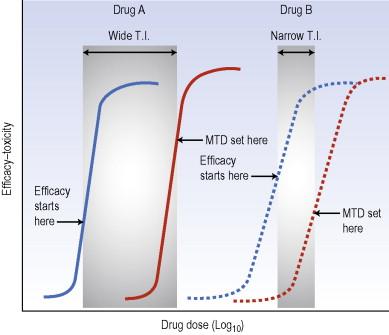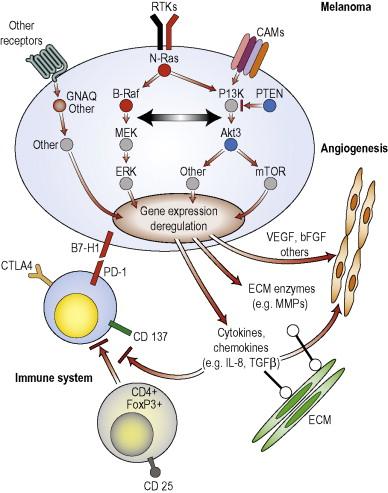Physical Address
304 North Cardinal St.
Dorchester Center, MA 02124
A number of targets in melanoma cells and the melanoma tumor microenvironment exist.
Early targeted clinical studies against the oncogenic form of B-Raf (V600E) using PLX-4032 have shown promising results.
Rational drug combinations will prevent inevitable drug resistance using single-agent therapies.
Conventional systemic chemotherapies and immunotherapies have not translated into clinically significant benefit for the treatment of melanoma and other skin cancers over the last 30 years, as summarized in a recent meta-analysis. In parallel with these largely unsuccessful clinical efforts, advances in understanding the biology of melanocytes, the genetic makeup of melanoma cells as well as the role of the tumor microenvironment have provided important insights regarding the role of several molecules in melanoma development and progression, and the resistance of melanoma cells to chemotherapy, and melanoma's genetic heterogeneity. Finally, the emergence of clinical-grade compounds that potently and specifically inhibit the pathways of progression has provided us with opportunities to make a significant impact in the lives of patients with metastatic melanoma (MM).
Targeted cancer therapies ideally take into consideration the higher, or even exclusive, expression of particular molecules in cancer cells and their neighboring host cells (immune, endothelial, and stromal cells) over the other normal cells of the body. If the above conditions are present, we may expect that treatment with agents that selectively and potently inhibit the target(s) will have a high therapeutic index ( Fig. 55.1 ). Obviously, successful use of targeted therapies is dependent upon the precise knowledge of the molecules/pathway(s) that drive the disease at a particular stage.

As in many other cancers, melanoma development and progression may be regarded as a complex process, rather than the isolated deregulation of melanocyte proliferation, cell senescence and survival mechanisms. Melanoma cells interact closely with and depend upon their microenvironment, defined as stromal, endothelial, and immune cells ( Fig. 55.2 ).

One of the most important recent advances in the field of melanoma has been the realization that it is a genetically heterogeneous disease, based on distinct molecular changes within different molecular pathways that can, to a certain extent, be clinically defined. This has triggered an increasing number of clinical trials in patients with MM testing molecularly targeted therapies. For example, constitutive activation of the Ras/Raf /MEK/ERK pathway is observed in up to 90% of melanoma patients and is most commonly mediated via mutations in N-Ras or B-Raf . , The Ras/PI3K/Akt cascade is another important signaling pathway that is activated in 60% of melanomas. In contrast with the Raf/MEK/ERK pathway, however, the activation of the PI3K/Akt3 pathway is usually secondary to activation of upstream receptor tyrosine kinases and other epigenetic mechanisms and less attributable to mutations. One of these upstream kinases is c-Kit, the stem cell factor receptor that, upon activation, triggers several other downstream events apart from PI3K activation, such as the MAPK kinase pathway. c-Kit aberrations, in the form of either mutations or gene amplifications, have been observed in up to 40% of mucosal, acral lentiginous, and chronically sun-damaged melanomas, providing opportunities for therapeutic intervention in this small subset of melanomas, as will be discussed below.
As a result of these and other deregulated signal transduction pathways, melanoma cells are able to shape their microenvironment by secreting growth factor(s) and other enzymes that stimulate lymph and blood vessel growth and/or acquire the ability to migrate, invade and metastasize. A number of angiogenic growth factors and their corresponding receptors have been shown to play an important role in melanoma, and they synergize with integrins, extracellular matrix components and matrix metalloproteinases. Furthermore, melanoma cells may secrete cytokines and chemokines that create an immunosuppressive microenvironment in which immune cells either cannot enter the tumor site or are present within the tumor but are dysfunctional and fail to eradicate the tumor. Over the last decade, a number of cells and molecules expressed by either the host immune or melanoma cells have been shown to play a role in tumor-mediated immune suppression, such as the immunosuppressive T regulatory cells (CD4 + CD25 + FoxP3 + ), the cytotoxic T-lymphocyte antigen 4 (CTLA-4), and the programmed cell death-1 (PD-1) protein.
Targeted therapies can be grouped based on the molecular target of interest and the presumed mechanism of action, i.e. in melanoma cell versus the cellular components of the tumor microenvironment (vascular endothelium, extracellular matrix, and immune cell compartment).
Become a Clinical Tree membership for Full access and enjoy Unlimited articles
If you are a member. Log in here